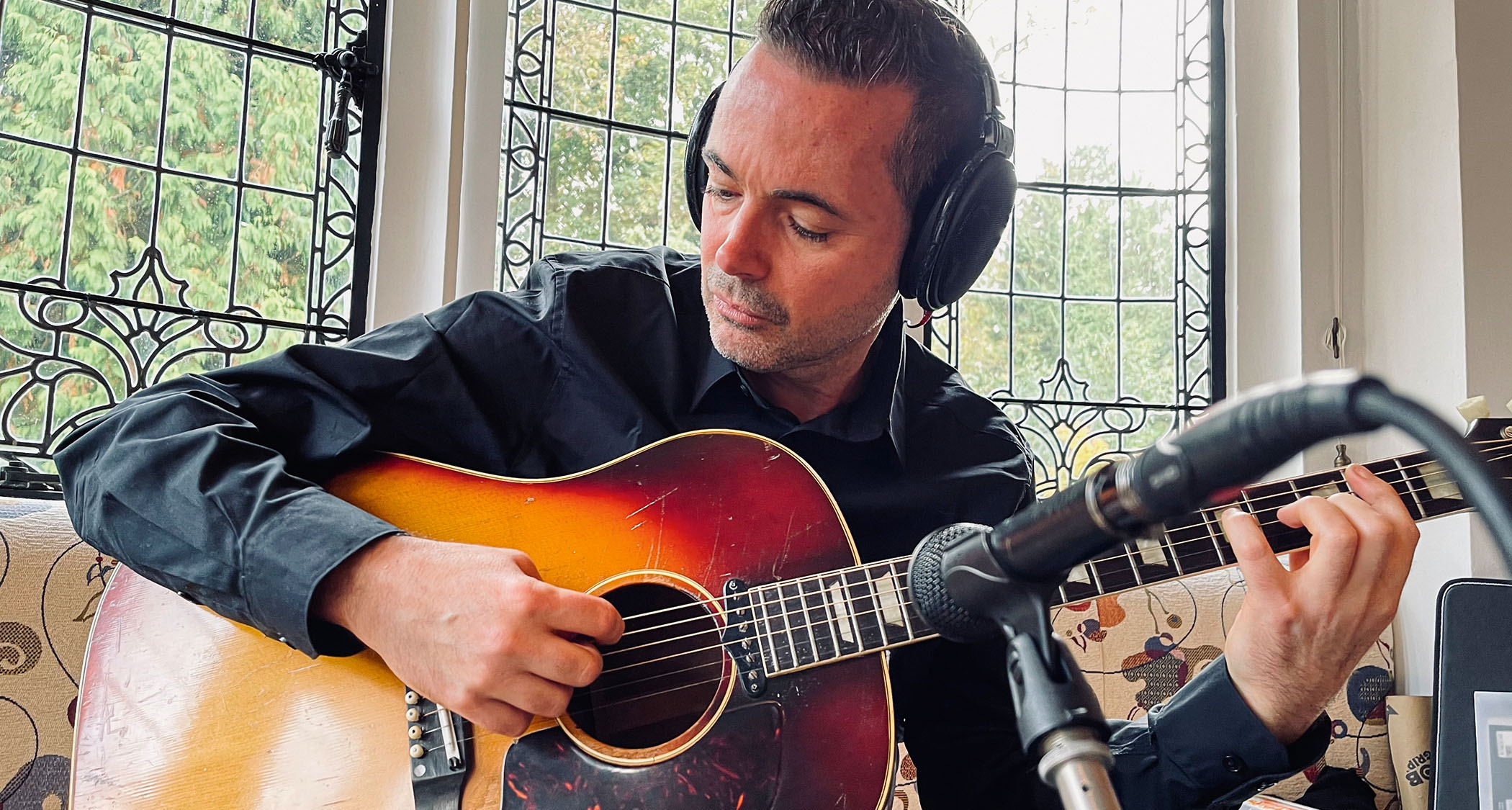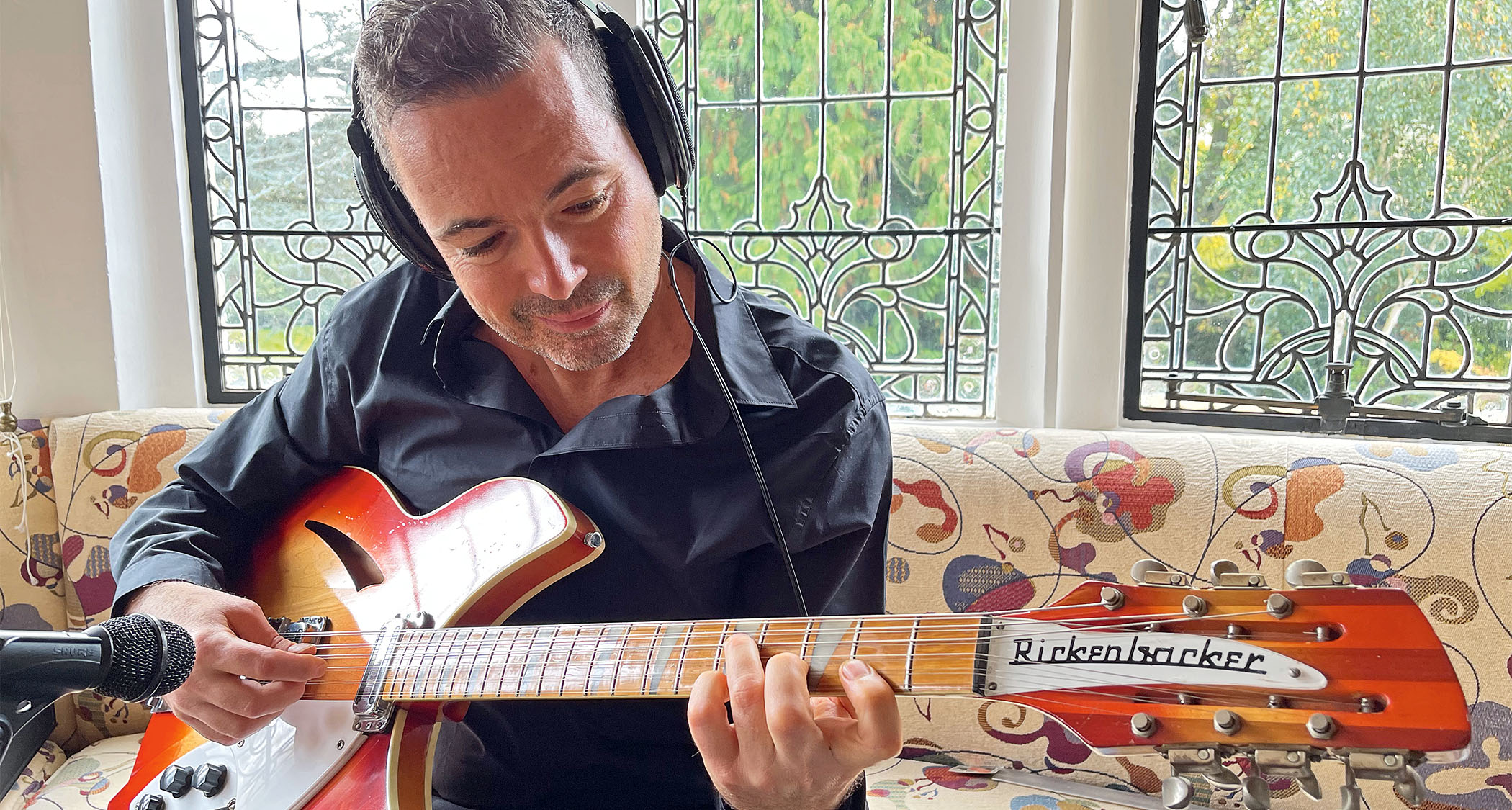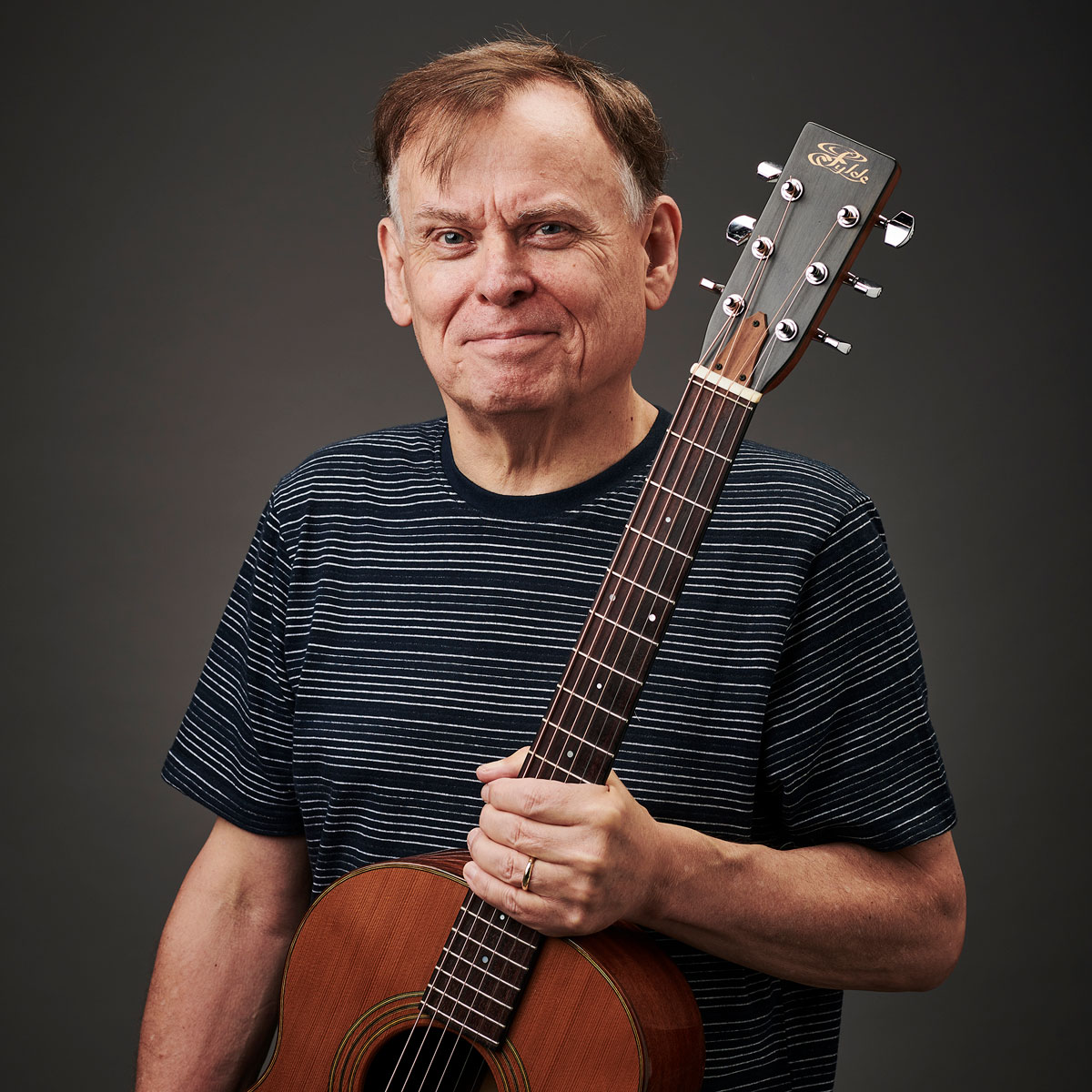“I asked Olivia, ‘I’d love to play one of George’s guitars.’ She just said, ‘Of course – which one?’” How a Gypsy jazz guitarist came to play George Harrison’s iconic Beatles guitars on a new tribute album
Recorded in Harrison’s home studio using his most famous instruments, Robin Nolan’s Gypsy jazz covers reimagine the quiet Beatle’s best moments – and finally completes Harrison’s ‘lost’ song…

Under normal circumstances, a Beatles covers album might not be headline news. But For The Love Of George – the latest release fom Robin Nolan, a player ranked among Britain’s greatest exponents of Gypsy jazz for three decades – is the final link in a chain of events so fantastical, improbable and downright surreal that, even now, there’s a hint of disbelief in his voice.
The seed of this project was planted in the mid-90s, when George Harrison personally invited the then-busker to perform at his Oxfordshire estate, Friar Park.
Nolan’s friendship with the family continued beyond Harrison’s death in 2001. And after plucking up courage during one particularly convivial soirée, the guitarist shared his vision: a new studio album that reinterpreted the quiet Beatle’s best moments in Gypsy jazz fashion, recorded on the fabled instruments in his music room.
Harrison’s widow, Olivia, not only agreed but went one better, inviting the younger guitarist to deploy the chords scribbled on an envelope by her late husband as the jump-off for a brand-new song.
“George’s songwriting is so incredible,” says Nolan. “He’s obviously overshadowed by the other two [John Lennon and Paul McCartney], but it’s just a joy to get his songs out there in this context.”
How did you first come into the orbit of George Harrison?
“So I came to Amsterdam to busk after I fell in love with Django Reinhardt’s music. I was living in London at the time, but it was challenging for playing this music. We didn’t have any gigs and we couldn’t really busk anywhere, but we heard about Amsterdam and there was this square called the Leidseplein. So we just turned up there and started playing and never went back. We worked on the street every day for, like, 10 years, and that’s how we learned and practised this music.
All the latest guitar news, interviews, lessons, reviews, deals and more, direct to your inbox!
“One day in ’94, one of George’s gardeners was on holiday here and he bought one of our CDs, and then gave it to George and Olivia back at Friar Park, and they obviously loved it. And then, luckily, my number was on the back. So I got a surreal call from George and didn’t believe it was him for ages.”

Tell us about your earliest memories of meeting George in person.
“He wanted us to come over and play at a party he was having at Friar Park, which is this incredible Gothic mansion in Henley-on-Thames. So one minute we’re playing under the tree on the Leidseplein; the next we’re playing for The Beatles.
“And, you know, everyone is famous except for us: Tom Petty, the Heartbreakers, Ravi Shankar, race car drivers, Monty Pythons, you name it. It’s that A-list kind of scene. We were just playing there in the background. And this kind of music, it’s nice for a party, so that went down really well.
George was so curious about the guitar. We played a bit together and it was like he just wanted to learn. He loved Django, Eddie Lang, and all that kind of stuff,
“George was so curious about the guitar. We played a bit together and it was like he just wanted to learn. He loved Django, Eddie Lang, and all that kind of stuff, and I think he liked us because we were kind of naive and just young kids. We weren’t in the business; we just wanted to play. We had that spirit, which I think he found refreshing.
“That was the beginning of the friendship with him, and with Olivia and Dhani [George and Olivia’s son]. We were kind of the house band at Friar Park. We would play at birthday parties or summer parties in the garden and it was always the same, like, ‘Oh my God, is that Eric Clapton?’ Obviously, you’re in a different world there. But we had a friendship going with his family and it was always something really special for me.
“Then George passed away in 2001 and we continued the friendship with Olivia and Dhani. In fact, the night before the Concert For George, held at the Royal Albert Hall [2002] a year after his passing, they had a special night at Friar Park where everyone was there, and we were playing. It was quite sombre and emotional.”
What were the first steps towards making the album, For The Love Of George?
“A couple of years ago, I was there at Friar Park again, playing at a very small dinner party for Olivia. We were just hanging about after dinner. It was a really nice atmosphere. I’ve always wanted to do a George Harrison project, so I just plucked up the courage and I asked Olivia: ‘I’d love to play on one of George’s guitars,’ because I knew they were upstairs. She just said, ‘Of course – which one?’ I just said, ‘Erm, the Ramírez?’
“She dashed upstairs and came back a second later – and then suddenly I was standing there holding the Ramírez, the flamenco guitar that George used on And I Love Her and Till There Was You. Of course, first of all I played the intro to And I Love Her and then I used that guitar for the rest of the night.
“Everyone’s sat around and we’re doing a little concert. Everything came together: I was in George’s house, playing the same notes on the frets where he played them, on that famous guitar. It was just an amazing feeling. It’s like there’s a vibe and a spirit you can’t put your finger on, but it was really special.”
It must have felt like a natural next step to suggest a studio album?
“Later on, I said, ‘Wouldn’t it be great to record an album on George’s guitars?’ Olivia thought it was a great idea. With all the logistics, it took a while to happen, but I did the backing tracks in Amsterdam and then eventually I came back to Friar Park with a recording guy and we were allowed into George’s guitar room – you know, the inner sanctum, surrounded by Beatles history, all the guitars and everything from his life.
“I recorded the guitar parts on his Ramírez and Gibson J-160E, which is the only guitar to be on every Beatles album. And then, on the title track, I used the Rickenbacker 12-string, which is the A Hard Day’s Night guitar.
“I felt a lot of responsibility. I know what George was like and he didn’t suffer fools – and he knew if you were just trying to be flash – so I wanted to be sincere for him. I think that comes across in the music on this album.”
I felt a lot of responsibility. I know what George was like and he didn’t suffer fools – and he knew if you were just trying to be flash
It’s amazing how well George’s songs lend themselves to the Gypsy jazz treatment.
“It is amazing. When I look at it objectively, sometimes it’s a challenge with epic songs like My Sweet Lord – you know, how do you turn that into a swing cover without being cheesy?
“I just managed to do it somehow on these songs, not falling into the trap of trying to mimic the song exactly but kind of making it a swing song or a Latin song. I was very careful to make his music sound beautiful in this context. I was really trying to be true to his melodies and his chords because they’re so interesting. People are seeing his songs in a different light now and the feedback has been amazing.”
The covers are fantastic. But this album also has an original song, doesn’t it?
“Yes, the other really interesting thing is the title track, For The Love Of George, which is published, amazingly, as a Harrison/Nolan composition. The chords are from him and the melody is me. Olivia texted me a picture of an envelope [pictured overleaf] and it just had chords scribbled down by George, like, a B minor crossed out and an arrow pointing to something else.
“She asked me: ‘Do you think George ever did anything with this? Why don’t you have a look?’ So I was staring at it and I really started getting the vibe. Like, ‘What did he mean here?’ I started to get a little bit obsessed and I slowly pieced it together, like, ‘Maybe this is what he was meaning?’ and I put together the chord sequence and then added a melody on top. I was trying to get something that was really ‘George’. I could kind of hear him humming this melody.
“Finally, I put the whole track together and then sent it back to Olivia, which was nerve-racking because she might not like it. But she said: ‘Oh, it sounds so George.’ That was really inspiring, you know? That song kind of spearheaded this project – and all three guitars are on that title track.”
It must have been difficult to actually sit in George’s studio and hold it together…
“I think, honestly, I just had one thing in mind, which was to make this album beautiful for him. I wasn’t trying to impress any other guitarists. Just handling any of those guitars, I felt beyond nervous, but it was more like I was channelling something really special for him when I was in that room. It wasn’t the kind of atmosphere where it was like, ‘Oh, let’s give it a couple of hours and come back.’
“I knew we didn’t have unlimited time in there, so I just really did it as intensely as possible. It was a real relief listening back and hearing how we’d captured those guitars. Like, ‘Oh yeah, that sounds good.’ Because we didn’t have a chance to listen back to anything at the time, I just did it with headphones.”
Handling those guitars, it must feel like you’re holding a piece of history.
“Yeah, absolutely. I mean, it was ridiculous recording And I Love Her with the Ramírez because it sounds exactly the same. And the A Hard Day’s Night Rickenbacker just sounds like The Beatles, you know?
“Then the Gibson – I think Paul and John had written I Saw Her Standing There and some of the early classics on that guitar. It was quite a high action and quite a challenge to play that one as well. It had a real gnarly kind of feel to it. You can’t help but be affected by the spirit of those guitars.
“You know, it might never happen again with those guitars. They’re in that room, and it’s basically like a museum – there’s not people just playing them and recording with them. Not Clapton, not Jeff Lynne, no-one. They’re just there and they’ll still be there when we’re all gone and someone will be curating them.
“It’s rock ’n’ roll history. It’s just that I have this unique relationship and friendship with the Harrisons that, you know, I was in the right position and had the idea to do it. It all came together. And it easily might not have – but it did.”
- For The Love Of George is available now on Dark Horse Records
- This article first appeared in Guitarist. Subscribe and save.
With over 30 years’ experience writing for guitar magazines, including at one time occupying the role of editor for Guitarist and Guitar Techniques, David is also the best-selling author of a number of guitar books for Sanctuary Publishing, Music Sales, Mel Bay and Hal Leonard. As a player he has performed with blues sax legend Dick Heckstall-Smith, played rock ’n’ roll in Marty Wilde’s band, duetted with Martin Taylor and taken part in charity gigs backing Gary Moore, Bernie Marsden and Robbie McIntosh, among others. An avid composer of acoustic guitar instrumentals, he has released two acclaimed albums, Nocturnal and Arboretum.
You must confirm your public display name before commenting
Please logout and then login again, you will then be prompted to enter your display name.






